
The Mutillidae are a family of more than 7,000 species of wasps whose wingless females resemble large, hairy ants. Their common name velvet ant refers to their resemblance to an ant, and their dense pile of hair, which most often is bright scarlet or orange, but may also be black, white, silver, or gold. Their bright colors serve as aposematic signals. They are known for their extremely painful stings,, and has resulted in the common name "cow killer" or "cow ant" being applied to the species Dasymutilla occidentalis. However, mutillids are not aggressive and sting only in defense. In addition, the actual toxicity of their venom is much lower than that of honey bees or harvester ants. Unlike true ants, they are solitary, and lack complex social systems.
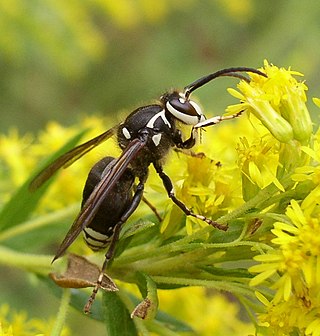
Vespoidea is a superfamily of wasps in the order Hymenoptera. Vespoidea includes wasps with a large variety of lifestyles including eusocial, social, and solitary habits, predators, scavengers, parasitoids, and some herbivores.
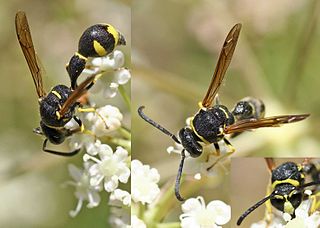
Eumenes is a genus of wasps in the subfamily Eumeninae. It is a large and widespread genus, with over 100 species and subspecies occurring worldwide. The genus was first proposed by Pierre André Latreille in 1802, with the type species later designated by Latreille in 1810. All species make jug-like nests out of mud, usually attached to twigs. The larvae are fed with caterpillars.
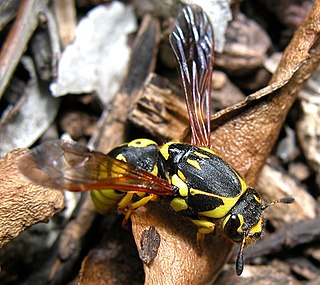
Pseudomasaris is a genus of pollen wasps of the family Vespidae, found in arid regions of western North America. They feed their larvae on the pollen and nectar of a variety of plants, though many species prefer flowers in the genus Phacelia. They are colored black with yellow or white markings that, in a few species, resemble the coloration of yellowjackets.

The Bradynobaenidae are a family of wasps similar to the Mutillidae, differing most visibly in the presence, in females, of a suture separating the pronotum from the mesonotum. These species are often found in arid regions.

Anoplius is a genus of spider wasps in the family Pompilidae called the blue-black spider wasps. It is one of two genera within the tribe Anopliini of subfamily Pompilinae.
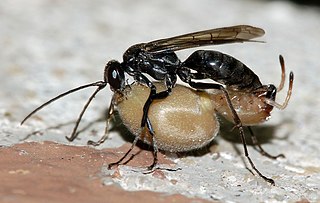
Auplopus is a large genus of spider wasps belonging to the subfamily Pepsinae of the spider wasp family Pompilidae, distributed throughout the world except for Antarctica. Auplopus wasps amputate the legs of their spider prey before transporting it to the nest.

Ceropales is a genus of kleptoparasitic spider wasps from the sub-family Ceropalinae of the family Pompilidae. They are characterised by the taking of the spider prey of other solitary wasps, mainly Pompilidae but members of the Sphecidae that provision with spider prey are sometimes also hosts. In some languages their name translates into English as "cuckoo spider wasp".
Priochilus is a genus of neotropical spider wasp in the family Pompilidae.
Condylodon is a genus of ant with an uncertain placement in the family Formicidae. It contains the single species Condylodon audouini, first described from a single specimen by Lund (1831) in a paper on Brazilian ants.

Tachypompilus is a genus of spider wasps, found in the Neotropics Nearctic, eastern Palearctic, Indomalayan and Afrotropics.

The Chyphotidae are a family of wasps with wingless females similar to the Mutillidae, differing most visibly in the presence, in females, of a suture separating the pronotum from the mesonotum. These species are found primarily in arid regions in the southwestern United States and adjacent regions in Mexico.
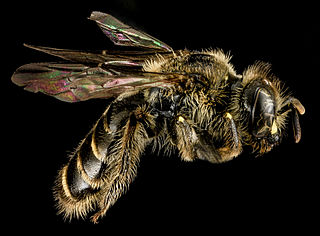
Calliopsis is a genus of panurgine bees in the family Andrenidae. There are over 80 described species distributed throughout the western hemisphere.
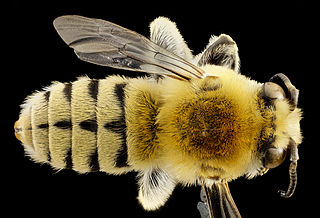
Habropoda is a genus of anthophorine bees in the family Apidae. There are at least 50 described species in Habropoda.

Dianthidium is a genus of leafcutter, mason, and resin bees in the family Megachilidae. There are at least 20 described species in Dianthidium.
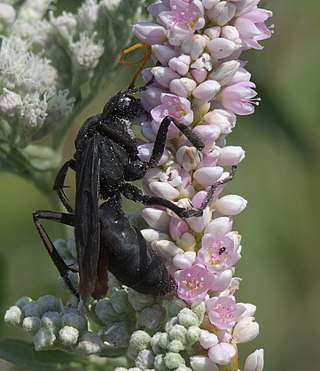
Entypus is a genus of spider wasps in the family Pompilidae. There are at least 40 described species in Entypus.
Eucerceris is a genus of wasps in the family Philanthidae. There are more than 40 described species in Eucerceris.

Chyphotes is a genus of wasps in the family Chyphotidae. There are more than 50 described species in Chyphotes found in the US and Mexico, all with wingless females.















